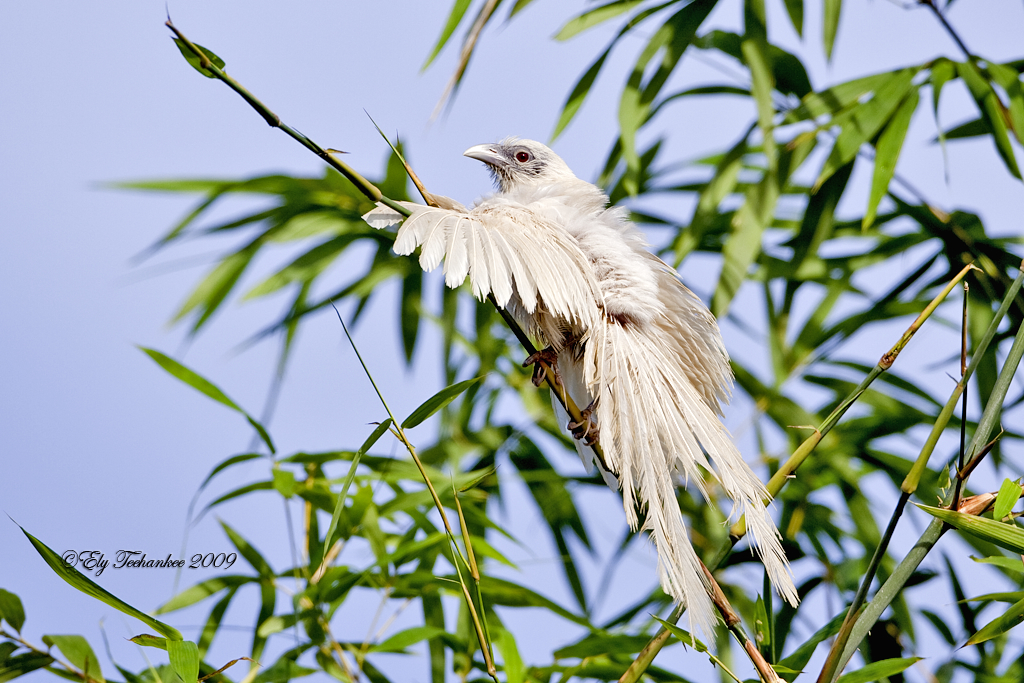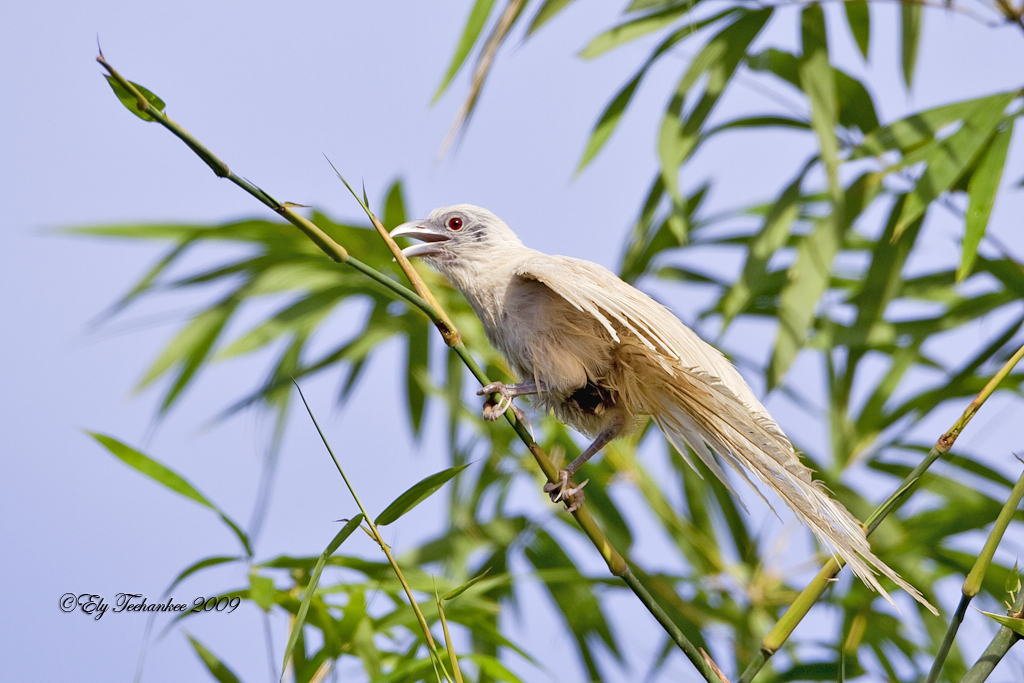|
|
Post by Ely Teehankee on Jul 10, 2009 2:36:51 GMT
These two pictures were taken in Palay Palay. Thanks to Eric and Romy who identified this lifer for me and mentioned that it is a rare capture. So here it is, even if the bird is still wet, I am very happy to share it with you. Canon 5DM2, EF 800mm F5.6 IS L Lens, Grip Mat on car window, ISO 400 1/640 @f8 for both pictures.   |
|
|
|
Post by Romy Ocon on Jul 10, 2009 2:48:51 GMT
Wow..... congrats again Ely on this rare capture - excellent detail, colors and exposure! Unless Bobby K or Nilo A posts a Cebu Flowerpecker photo in the next 3 days, this should be a front-runner for the FBPOTW honors.  |
|
|
|
Post by Martin Alvendia on Jul 10, 2009 3:24:07 GMT
Oh my Kamote!!! Wonderful Wonderful Wonderful Capture of this elusive bird! I've been drooling to get a picture of this bird since I've started in photography. BIG Congrats Ely!
|
|
|
|
Post by Elvin Sansona on Jul 10, 2009 3:28:27 GMT
Very rare talaga only occur one in 1800 individuals, thanks for the post it did give me a glimpse of this rare genetic phenomenon
|
|
|
|
Post by Ely Teehankee on Jul 10, 2009 3:36:46 GMT
Thank you Romy. I learned something from this experience. "Do not judge a book by its cover". When I saw the bird in the monitor, all wet & disheveled I said to myself how "sayang" to take a picture of a bird looking like this. I forgot that to be able to take a picture of a bird should be enough to make a person happy as they are not easy to come by. It did not cross my mind that a picture of a rare bird could also be worthwhile. If Bobby or Nilo do post a better picture, they will deserve the honors because these guys are good.
|
|
|
|
Post by Ely Teehankee on Jul 10, 2009 3:42:42 GMT
Thank you Elvin. Where did you get the statistics of this bird. That is very interesting to know.
|
|
|
|
Post by Ely Teehankee on Jul 10, 2009 3:44:40 GMT
Thank you Martin. I did not know that it is that rare for one to wish for. Thank you.
|
|
|
|
Post by Elvin Sansona on Jul 10, 2009 3:46:54 GMT
Sir Ely I took the info from Wikipedia that cited this journal: "Albinism". Terres, John. K. The Audubon Society Encyclopedia of North American Birds, New York: Alfred A. Knopf, 1980. ISBN 0-394-46651-9. Mr. Google is so generous!
|
|
|
|
Post by Mark Itol on Jul 10, 2009 4:49:42 GMT
Wow. Very interesting and very nicely captured, Ely. Thanks for sharing.  |
|
|
|
Post by Edu Lorenzo Jr on Jul 10, 2009 5:22:31 GMT
Wikipedia on the other hand states only 1 in 17,000 humans have albinism. This number should be accurate because in humans, albinism is easier recorded. In other animals (such as birds for this case) albinism is very rarely recorded as since they are white, they get spotted by predators (in this case by a bird photographer) really quick and sadly becomes lunch or dinner before they even become juveniles.
This albino coucal should consider itself really lucky to reach adulthood. And gives these photos uniqueness in many levels. First of course is that the albino survived. Second, capturing plumage of a pure white bird is a definite challenge even for the most seasoned of photographers.
Congratulations to sir ElyTee for bagging this image and thank you so much for sharing the photo.
|
|
|
|
Post by Agerico M. De Villa on Jul 10, 2009 6:45:35 GMT
In birds, I remember it is 1 in 20,000. However, I have already forgotten which scientific journal I have gotten this information from. The case of the Philippine coucal is more of the "white phase" or the "morph" rather than albinism. I have earlier suggested that this might be a case of a new species but my suggestion has only stirred a controversy within the WBCP. We used to have a stuffed individual in house and its legs have been more of grayish than pinkish. I have been spotting it on several occasions in different areas here in Luzon but I have never been able to photograph it.
Congratulations!
|
|
|
|
Post by Ely Teehankee on Jul 10, 2009 9:18:49 GMT
From what you guys have said, the statistics made this bird more interesting. Thank you Elvin, Mark, Edu, and Prop Jerry for your appreciation.
|
|
|
|
Post by Clemn A. Macasiano Jr. on Jul 10, 2009 10:09:09 GMT
Wow ! Rare & Exquisite Capture. Right place in the right time with the 800mm !
@ Nilo / Bobby / Raul .... Go go go . Get the Cebu flower Pecker ! Sama ako camping ! ha ha ha
|
|
|
|
Post by Elvin Sansona on Jul 10, 2009 10:20:04 GMT
albinism and other genetic anomalies spur a very deep discussion. it is very interesting because aside from rare occurrence it is also a deviation of natural phenotypic expression and a lens magnet too!
|
|
|
|
Post by Raul Benjamin Puentespina on Jul 10, 2009 10:22:05 GMT
Congrats Ely....wow great photo of the elusive rare albino Phil Coucal....
Dr. BoyMac...Im going home to Cebu next week (Monday to Friday)...to join Bobby and Nilo for the Cebu flowerpecker adventure in Tabunan or Alcoy...join us.... ;D
|
|
|
|
Post by Clemn A. Macasiano Jr. on Jul 10, 2009 10:33:59 GMT
Congrats Ely....wow great photo of the elusive rare albino Phil Coucal.... Dr. BoyMac...Im going home to Cebu next week (Monday to Friday)...to join Bobby and Nilo for the Cebu flowerpecker adventure in Tabunan or Alcoy...join us.... ;D OT: Go ! Maybe we can capture an images of Albino Cebu Flower Pecker. ;D But maybe there's a lot of snake around while waiting for the CFP bird. |
|
|
|
Post by ppaaoolloo on Jul 10, 2009 20:30:16 GMT
Great work Ely  |
|
|
|
Post by Ely Teehankee on Jul 10, 2009 23:57:48 GMT
Thank you Elvin. Looks like you do a lot of reading about birds.
Thany you Raul. I like the looks of the bird in your Avatar. What kind of a bird is it?
Thank you Dr Boy Mac. Let me know how your Birding trip went with Bobby & Nilo. I saw the Cebu Flowerpecker at the KB and its a beautiful bird. Go for it
Thank you Paolo. When are you going Birding? I have not seen your pictures lately.
|
|
|
|
Post by Ding Carpio on Jul 11, 2009 0:33:27 GMT
A big big congrats, Ely! That is, so far, the best shot I've seen of this rarity, wet notwithstanding.
|
|
|
|
Post by Rene Calado Jr. on Jul 11, 2009 1:49:56 GMT
Hi Everyone!
I agree with Prof. Jerry. I guess for the meantime, it seems that it is more proper to call it Philippine Coucal "White Phase" or "White Form/Morph" than Albino Philippine Coucal.
In albinism, the production of the dark pigment is completely blocked. As such, the feathers, eyes, feet, and nails contain no dark pigments. What remains is a completely white bird with red eyes, flesh colored feet and horn colored nails.
The bird you photographed has brownish eyes, grayish beak and feet. We don't know if the bird is just undergoing a "phase" and later on would revert back to its normal wild-type color. On the other hand, this color morph can also be type of dark pigment reducing mutation (but not albinism) and if it is so, then it will just a matter of time when we shall see more of them in the future!
Best regards,
Wagtail
|
|